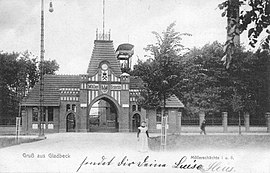Möller colliery
| Möller colliery | |||
|---|---|---|---|
| General information about the mine | |||
| historical postcard view from 1904 | |||
| Information about the mining company | |||
| End of operation | 1967 | ||
| Funded raw materials | |||
| Degradation of | Hard coal | ||
| Geographical location | |||
| Coordinates | 51 ° 34 '18.6 " N , 6 ° 58' 9.2" E | ||
|
|||
| Location | Gladbeck | ||
| local community | Gladbeck | ||
| District ( NUTS3 ) | Recklinghausen | ||
| country | State of North Rhine-Westphalia | ||
| Country | Germany | ||
| District | Ruhr area | ||
The bill Möller was a coal - mine in Gladbeck .
history
In 1894, several individual trades consolidated their field holdings under the city limits between Bottrop and Gladbeck and founded the United Gladbeck union .
This began in Rentfort in 1895 with the lowering of the Thyssen 1/2 double shaft system . Due to a water ingress, the sinking work had to be temporarily interrupted in 1896, whereupon the sinking of the Professor 3/4 pit began in the southern pit field area . The Thyssen and Professor pits were consolidated under the name Zeche Vereinigte Gladbeck . In 1898 the devil work was resumed; In 1901 the Thyssen 1/2 mine went into production. In the same year the Prussian state founded the mining company Recklinghausen, which in addition to a few other mine fields on the northern edge of the Ruhr area also the Ver. Gladbeck took over.
The pit Thyssen 1/2 was named after the former Prussian trade minister Theodor von Moeller in Möller bays renamed. Shaft Möller 1 was equipped with a German strut frame and an auxiliary frame standing at right angles to it for double conveyance, while shaft 2 received only one access system.
From 1905 the mining company Recklinghausen was managed in personal union with the Hibernia AG . This led the Möller colliery together with the Rheinbaben colliery (formerly Professor 3/4) as mining inspection 2. In 1911 a coking plant was put into operation at Möller 1/2 . In 1915 a weather shaft was sunk between the two shafts . Because of the retention of the common consecutive shaft numbering, this shaft was named Möller 5 and assigned to the Möller plant management.
In 1927, the mining company Recklinghausen was completely taken over by Hibernia AG . Mining inspection 2 was separated in the Gladbeck mine with the independent plant divisions Möller and Rheinbaben. The coking plants in both shafts were gradually shut down. From 1936 both pits were continued as individual mines. The annual production of the coal mine Möller 1/2, 5 amounted to 600,000 tons of coal.
From 1940 the modern conveying and processing systems of the Rheinbaben colliery were also used. The Möller 1 shaft structure was converted into a simple strut structure. From 1945 to 1947, the entire conveyance through the Möller 1 shaft had to be temporarily completely taken over, as the main Rheinbaben 3/4 conveyor system was shut down due to the war.
Shutdown
Due to the coal crisis of the 1960s, the Möller and Rheinbaben collieries were completely merged to form the Möller / Rheinbaben composite mine . In 1967 the composite mine was shut down because Hibernia AG refrained from further expansion of the mine in favor of the neighboring shafts. The employees were taken over by other Hiberniazechen.
Shafts Möller 1 and 2 were filled and the daytime facilities were demolished. The Möller 5 shaft was assigned to the Jacobi / Franz Haniel composite mine as a weather shaft .
Current condition
On the site of the Möller 1/2 colliery, businesses have gradually been established, which hardly shows anything of the original use.
literature
- Wilhelm Hermann, Gertrude Hermann: The old mines on the Ruhr. 6th expanded and updated edition, Verlag Karl Robert Langewiesche, successor Hans Köster KG, Königstein i. Taunus, 2006, ISBN 3784569943

